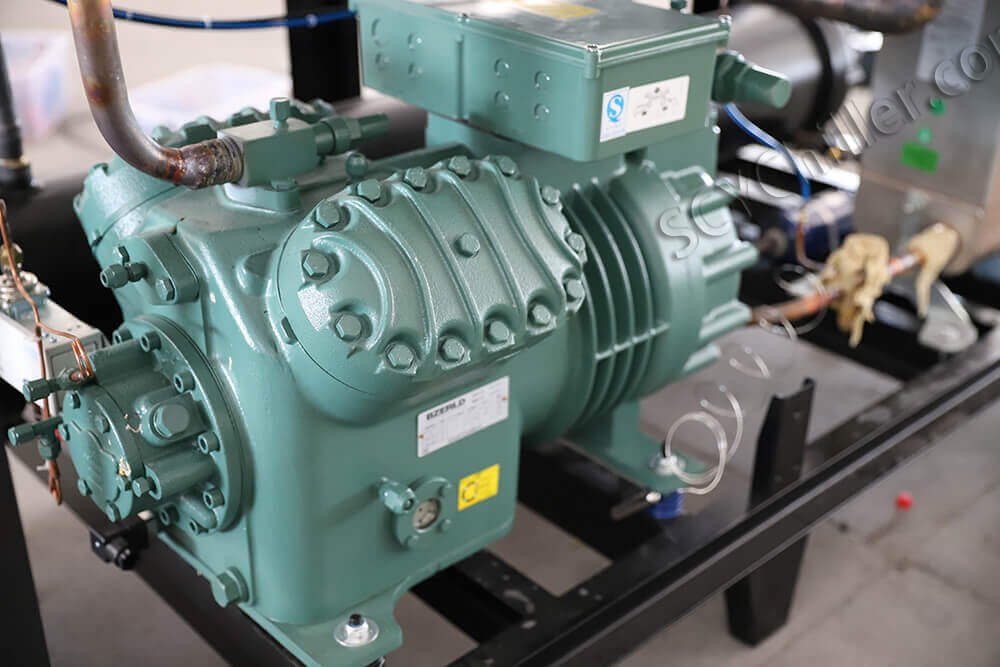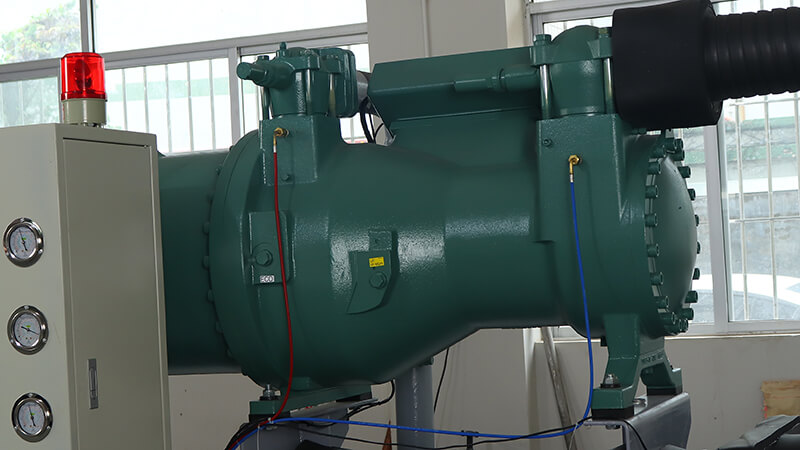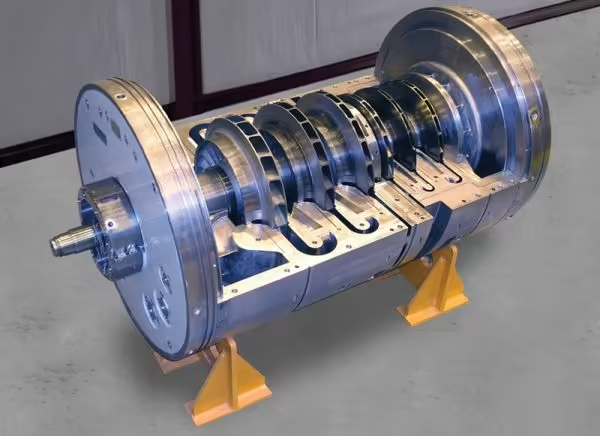Kältemittel sind für die Kühlung in Branchen, gewerblichen Gebäuden und Rechenzentren von entscheidender Bedeutung, und der Kompressor ist ihr Kraftpaket, das den Kühlzyklus vorantreibt. Durch die Auswahl des richtigen Kompressortyps kann die Effizienz, Zuverlässigkeit und Kostenwirksamkeit eines Kaltes die Effizienz, die Effizienz, die Kosteneffizienz eines Kaltes brechen. In dieser Anleitung werden die Haupttypen von Kaltkompressoren untersucht - Reciprocing, Rotary Vane, Scrollen, Schrauben und Zentrifugal -, wie sie funktionieren, deren Stärken, Schwächen und wo sie leuchten und Ihnen helfen, die besten Anforderungen für Ihre Kühlbedürfnisse zu wählen.
Was ist ein Kaltkompressor?
Ein Kaltkompressor pumpt Kältemittel durch das System und komprimiert Niederdruckgas in einen Hochdruck-Hochtemperaturzustand, um den Kühlprozess zu starten. Es ist das Herz des Dampfkompressionszyklus, in dem Kältemittel Wärme aus einem Flüssigkeit (wie Wasser) im Verdampfer absorbiert, komprimiert wird, Wärme im Kondensator freigibt und sich wieder ausdehnt, um sich erneut abzukühlen. Compressors vary in design, each suited to specific cooling loads, from small offices to massive factories.
How Compressors Work
All chiller compressors follow the same basic principle:
- Aufnahme: Low-pressure refrigerant gas enters from the evaporator.
- Kompression: The compressor squeezes the gas, raising its pressure and temperature (e.g., to 150°F or 66°C).
- Entladung: Hot, high-pressure gas flows to the condenser, where it releases heat.
- Zyklus: The refrigerant continues to the expansion valve and evaporator, repeating the process.
Das Design des Kompressors - ob Kolben, Schrauben oder Anspker - bestimmt, wie es das Gas komprimiert und die Effizienz, Rauschen und Wartung beeinflusst.
Types of Chiller Compressors
Umfangskompressoren

- How They Work: Pistons driven by a crankshaft compress refrigerant in cylinders, like a car engine. Gas enters, gets squeezed, and exits at high pressure.
- Anwendungen: Small to medium chillers (5–150 tons), used in commercial buildings, retail, or older industrial setups.
- Vorteile:
- Cost-effective, with lower upfront costs.
- Handles variable loads well, ideal for fluctuating demands.
- Simple design, easy to repair with widely available parts.
- Nachteile:
- Noisy due to piston movement, often 80–90 dBA.
- Höhere Wartung von vielen beweglichen Teilen (Ventile, Kolben).
- Weniger effizient, mit Cops um 2,5–3,0.
- Beispiel: Eine 50-Tonnen-Kälte, die ein kleines Büro abkühlt und 600.000 BTU/h mit erschwinglicher Zuverlässigkeit abwickelt.
Rotationsschaufelkompressoren

- How They Work: Ein Rotor mit Schubschaufeln in einer zylindrischen Kammer, die das Kältemittel beim Ausdehnen und Rückzug des Kältemittels fängt und zusammenbricht.
- Anwendungen: Kleinere Kälte (1–30 Tonnen), oft in tragbaren Einheiten oder leichten kommerziellen Umgebungen wie Restaurants.
- Vorteile:
- Kompakte und leichte, angemessene enge Räume.
- Ruhiger als sich erwidert, rund 60 bis 70 dba.
- Glätterer Betrieb mit weniger Vibrationen.
- Nachteile:
- Begrenzte Kapazität, nicht für große Lasten geeignet.
- Die Flüche tragen schneller ab und müssen alle 3 bis 5 Jahre ersetzt werden.
- Moderate efficiency, with COPs of 2.8–3.2.
- Beispiel: A 10-ton rotary vane chiller cooling a café, maintaining 72°F (22°C) with minimal noise.
Scroll Compressors

- How They Work: Two spiral-shaped scrolls interlock—one fixed, one orbiting—to compress refrigerant in shrinking pockets, pushing it to the center.
- Anwendungen: Small to medium chillers (10–100 tons), popular in offices, schools, and light industrial use.
- Vorteile:
- Quiet, around 50–60 dBA, ideal for noise-sensitive areas.
- High efficiency, with COPs of 3.0–3.5, saving energy.
- Fewer moving parts, reducing maintenance needs.
- Nachteile:
- Higher initial cost than reciprocating.
- Limited to smaller capacities, less effective above 100 tons.
- Sensitive to liquid refrigerant, requiring careful control.
- Beispiel: A 30-ton scroll chiller in a school, cooling classrooms to 70°F (21°C) with low noise and energy use.
Schraubenkompressoren

- How They Work: Two interlocking helical rotors (screws) rotate, trapping and compressing refrigerant from one end to the other.
- Anwendungen: Medium to large chillers (70–600 tons), used in factories, hospitals, and data centers.
- Vorteile:
- High efficiency, with COPs of 3.5–4.0, even at partial loads.
- Reliable for continuous operation, lasting 20–25 years.
- Handles large capacities well, up to 600 tons.
- Nachteile:
- Expensive upfront, often 20–30% more than scroll.
- Complex maintenance, needing specialized technicians.
- Moderate noise, around 70–80 dBA.
- Beispiel: A 200-ton screw chiller in a factory, cooling machinery at 50°F (10°C), running 24/7 with high efficiency.
Centrifugal Compressors

- How They Work: A spinning impeller accelerates refrigerant, using centrifugal force to compress it, often with multiple stages for high pressure.
- Anwendungen: Large chillers (200–2,000 tons), ideal for district cooling, airports, or industrial plants.
- Vorteile:
- Top efficiency, with COPs of 4.0–6.0, especially at full load.
- Low maintenance, with magnetic bearings reducing wear.
- High capacity, handling massive loads like 24 million BTU/h.
- Nachteile:
- Very high initial cost, sometimes $500,000+.
- Poor efficiency at low loads, below 30% capacity.
- Large footprint, needing significant space.
- Beispiel: A 1,000-ton centrifugal chiller in a data center, keeping servers at 68°F (20°C) with unmatched efficiency.
| Kompressortyp | Anfängliche Kosten | Energy Efficiency (Full Load) | Part-Load Performance | Wartungsbedürfnisse | Typical Capacity Range |
|---|---|---|---|---|---|
| Reciprocating | Niedrig | Mäßig | Gut | Hoch | Klein bis mittel (bis zu ~ 150 Tonnen) |
| Scrollen | Mäßig | Gut | Gut | Niedrig | Medium (up to ~200 tons) |
| Schrauben | Hoch | Gut | Exzellent | Mäßig | Medium to Large (up to 500 tons) |
| Zentrifugal | Hoch | Exzellent | Poor (improves with VSD) | Niedrig | Large to Very Large (>200 tons) |
Choosing the Right Compressor
Selecting a compressor depends on:
- Kühllast: Klein (scrollen, recripieren), mittel (Schraube, Scrollen) oder groß (Zentrifugal, Schraube).
- Effizienzbedarf: Hoher COP für Energieeinsparungen (Zentrifugal, Schraube) oder budgetfreundlich (Hubkolben).
- Raum: Kompakt (scrollen, platte) oder größer (Schale und Rohr).
- Lärm: Ruhig (scrollen) oder erträglich (Schraube, Zentrifugal).
- Budget: Niedrigere Kosten (Hubkrocken) im Vergleich zu langfristigen Einsparungen (Schraube, Zentrifugal).
Beispielsweise könnte ein kleines Büro einen 20-Tonnen-Scroll-Kältemittel für eine ruhige Effizienz auswählen, während eine Chemieanlage für eine Zuverlässigkeit für einen 500-Tonnen-Schraubenkühler entscheiden könnte.
Wartungstipps
Halten Sie die Kompressoren reibungslos mit:
- Oil Checks: Change synthetic oil (e.g., POE) every 1–2 years, checking levels monthly.
- Filterreinigung: Replace air and oil filters every 6–12 months to avoid clogs.
- Vibration Monitoring: Inspect quarterly for unusual shakes, signaling wear.
- Refrigerant Levels: Verify quarterly; a 5% loss cuts efficiency by 8%.
- Professional Service: Annual tune-ups catch issues early, saving 10–20% on energy.
Abschluss
Chiller compressors—reciprocating, rotary vane, scroll, screw, and centrifugal—each bring unique strengths to cooling systems. Von ruhigen Schriftrolleneinheiten in Büros bis hin zu leistungsstarken Zentrifugalkühler in Fabriken hilft Ihnen das Verständnis ihrer Funktionen und Anwendungen bei der Auswahl mit Bedacht. Mit ordnungsgemäßer Wartung und einem Auge auf Trends wie Kältemittel mit niedrigem GWP können Sie in den kommenden Jahren Effizienz, Zuverlässigkeit und Kosteneinsparungen gewährleisten.
FAQ
1. What is a chiller compressor?
A chiller compressor is the component that compresses refrigerant gas, driving the refrigeration cycle to remove heat and provide cooling.
2. What are the main types of chiller compressors?
The main types are reciprocating, rotary vane, scroll, screw, and centrifugal, each suited to different cooling capacities and applications.
3. Which compressor is best for small chillers?
Scroll compressors are ideal for small chillers (10–100 tons) due to their quiet operation and efficiency.
4. What’s the most efficient compressor type?
Centrifugal compressors are typically the most efficient, with COPs of 4.0–6.0, especially for large loads, followed by screw compressors.
5. How do I choose the right compressor for my chiller?
Consider cooling load, efficiency needs, space, noise, and budget. Consult an engineer to match your specific requirements.
6. What are the maintenance needs for chiller compressors?
Regular oil changes, filter replacements, vibration checks, and refrigerant monitoring, with annual professional servicing.
7. How do compressor types affect energy costs?
High-efficiency types like centrifugal and screw save energy (COP 3.5–6.0), while reciprocating may use more (COP 2.5–3.0).
8. Are there eco-friendly compressor options?
Yes, newer models use low-GWP refrigerants like R-32, and centrifugal units with magnetic bearings reduce environmental impact.
9. What’s the lifespan of a chiller compressor?
With maintenance: reciprocating (10–15 years), scroll (15–20 years), screw (20–25 years), centrifugal (25+ years).
10. How noisy are chiller compressors?
Reciprocating are loudest (80–90 dBA), scroll quietest (50–60 dBA), screw and centrifugal moderate (70–80 dBA).
